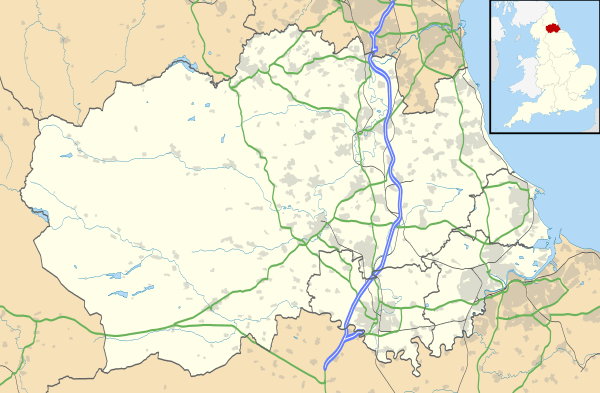RAF Middleton St George
RAF Middleton St. George | |||||||||||||||||||
|---|---|---|---|---|---|---|---|---|---|---|---|---|---|---|---|---|---|---|---|
| IATA: none – ICAO: none | |||||||||||||||||||
| Summary | |||||||||||||||||||
| Airport type | Military | ||||||||||||||||||
| Owner | Air Ministry | ||||||||||||||||||
| Operator |
Royal Air Force Royal Canadian Air Force | ||||||||||||||||||
| Location | Middleton St. George | ||||||||||||||||||
| Coordinates | 54°30′33″N 001°25′46″W / 54.50917°N 1.42944°WCoordinates: 54°30′33″N 001°25′46″W / 54.50917°N 1.42944°W | ||||||||||||||||||
| Map | |||||||||||||||||||
 RAF Middleton St. George Location in County Durham | |||||||||||||||||||
| Runways | |||||||||||||||||||
| |||||||||||||||||||

RAF Middleton St. George was a Royal Air Force (RAF) Bomber Command station during World War II. It was located in County Durham, five miles east of Darlington, England.
History
Second World War
The airfield began its life as Royal Air Force Goosepool, and in 1941 became RAF Middleton St. George. The aerodrome opened as a Bomber Command station in 1941. In 1943 it was allocated to No. 6 Group, Royal Canadian Air Force. A sub-station was located at RAF Croft, Yorkshire. Squadrons based here include: 76 Squadron, which flew Handley Page Halifaxes, 78 Squadron, which flew Armstrong Whitworth Whitleys, 419 Squadron RCAF, which flew Vickers Wellingtons, Halifaxes, and Avro Lancasters, 420 Squadron RCAF, which flew Wellingtons, and 428 Squadron RCAF, which flew Wellingtons, Halifaxes, and Lancasters.
Post war
After the war, the aerodrome served various squadrons and units including No. 13 Operational Training Unit (OTU), No. 2 Air Navigation School, No. 4 Flying Training School, and squadrons that used Gloster Meteors, Hawker Hunters, Gloster Javelins and English Electric Lightnings.
The RAF left the station in 1964, but the aerodrome was reopened in 1966 as a civil airport. The airfield was named Teesside International Airport in the 1960s, and was renamed Durham Tees Valley Airport in 2004. In the late 1980s the entire Married Quarter estate was sold to a Roger Byron-Collins company and was renamed The Virginia Estate.
From 1968 to 1979, some of the former station buildings housed Middleton St George College of Education, a teacher training college.[1]
Units and aircraft
| Unit | Dates | Aircraft | Variant | Notes |
|---|---|---|---|---|
| No. 33 Squadron RAF | 1958–1962 | Gloster Javelin | FAW.7 and FAW.9 from 1960 | Twin-engined jet fighter/interceptor.[2] |
| No. 76 Squadron RAF | 1941–1942 | Handley Page Halifax | Mks.I and II | Four-engined piston heavy bomber.[3] |
| No. 78 Squadron RAF | 1941 | Armstrong Whitworth Whitley | Mk.V | Twin-engined medium bomber.[3] |
| 1942 | Handley Page Halifax | Mk.II | Four-engined piston heavy bomber.[3] | |
| No. 92 Squadron RAF | 1957 1958-1960 | Hawker Hunter | F.6 | Single-engined jet fighter/fighter-bomber.[4] |
| No. 264 Squadron RAF | 1957 | Gloster Meteor | NF.14 | Twin-engined jet night-fighter.[5] |
| No. 419 Squadron RCAF | 1942–1944 | Handley Page Halifax | Mk.II | Four-engined piston heavy bomber.[6] |
| 1944–1945 | Avro Lancaster | Mk.X | Four-engined piston heavy bomber.[6] | |
| No. 420 Squadron RCAF | 1942–1943 | Vickers Wellington | Mks.III and later X before move to North Africa | Twin-engined medium bomber.[6] |
| No. 428 Squadron RCAF | 1943–1944 | Handley Page Halifax | Mks.V and II | Four-engined piston heavy bomber.[6] |
| 1944–1945 | Avro Lancaster | Mk.X | Four-engined piston heavy bomber.[6] |
- 1947-1948 No. 13 Operational Training Unit RAF de Havilland Mosquito Mk.T3 & Mk 6.
- 1951-1953 No. 205 Advanced Flying School RAF Gloster Meteor Mk7 & Mk 8.
- 1963-1964 No. 226 Operational Conversion Unit RAF English Electric Lightning
References
Citations
- ↑ Reunion website
- ↑ Jefford 1988, p. 36.
- 1 2 3 Jefford 1988, p. 48.
- ↑ Jefford 1988, p. 52.
- ↑ Jefford 1988, p. 80.
- 1 2 3 4 5 Jefford 1988, p. 91.
Bibliography
- Halley, James J. (1988). The Squadrons of the Royal Air Force & Commonwealth, 1918-1988. Tonbridge, Kent, UK: Air-Britain (Historians) Ltd. ISBN 0-85130-164-9.
- Jefford MBE, Wg Cdr C G (1988). RAF Squadrons. A comprehensive record of the movement and equipment of all RAF squadrons and their antecedents since 1912. Shrewsbury: Airlife. ISBN 1-85310-053-6.
- Moyes, Philip J.R. (1976). Bomber Squadrons of the RAF and their Aircraft. London: Macdonald and Jane's (Publishers) Ltd. ISBN 0-354-01027-1.
External links
| Wikimedia Commons has media related to RAF Middleton St. George. |
- 76 Squadron History
- 78 Squadron history and current status
- 419 Squadron History
- 420 Squadron History
- 428 Squadron History
- 608 Squadron History
